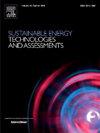Power adaptive control strategy for multi-stack PEM photovoltaic hydrogen systems considering electrolysis unit efficiency and hydrogen production rate
IF 7.1
2区 工程技术
Q1 ENERGY & FUELS
Sustainable Energy Technologies and Assessments
Pub Date : 2025-01-27
DOI:10.1016/j.seta.2025.104200
引用次数: 0
Abstract
To address the issue of low efficiency and hydrogen production caused by prolonged low-power operation in some electrolyzers under fluctuating photovoltaic power in multi-stack hydrogen systems, we propose a power adaptive distribution strategy for Proton Exchange Membrane Electrolyzers. This strategy considers electrolyzer efficiency and hydrogen production, incorporating electrolysis efficiency, Faraday efficiency, auxiliary equipment efficiency, and converter efficiency. The Dung Beetle Optimization algorithm is used for offline calculations, combined with fuzzy PID control for real-time power optimization. A case study based on actual data from a hydrogen project in Turpan, Xinjiang, shows that after 4500 mins of operation in a system with four electrolyzers, the proposed method increases total hydrogen production by 9.94%, 2.34%, and 4.87% compared to traditional average distribution, Daisy chain distribution, and efficiency-based distribution strategies, respectively. Additionally, the strategy reduces the low-power and full-load operation times of the electrolyzers, extending the equipment’s lifespan. This approach provides a new solution for ensuring stable and efficient operation of hydrogen production systems under complex conditions.
求助全文
约1分钟内获得全文
求助全文
来源期刊

Sustainable Energy Technologies and Assessments
Energy-Renewable Energy, Sustainability and the Environment
CiteScore
12.70
自引率
12.50%
发文量
1091
期刊介绍:
Encouraging a transition to a sustainable energy future is imperative for our world. Technologies that enable this shift in various sectors like transportation, heating, and power systems are of utmost importance. Sustainable Energy Technologies and Assessments welcomes papers focusing on a range of aspects and levels of technological advancements in energy generation and utilization. The aim is to reduce the negative environmental impact associated with energy production and consumption, spanning from laboratory experiments to real-world applications in the commercial sector.
 求助内容:
求助内容: 应助结果提醒方式:
应助结果提醒方式:


